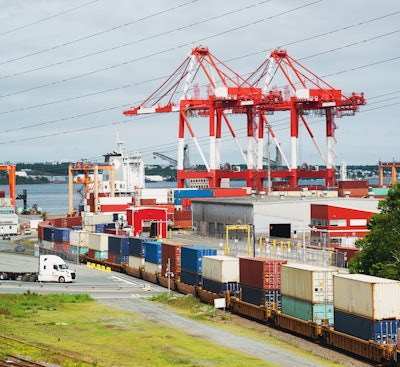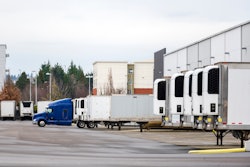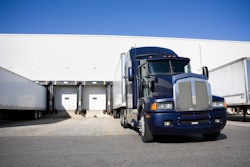
A COVID vaccine mandate, which entered the Federal Register Nov. 5, will require more than 730,000 employees in the trucking industry – including drivers – to be vaccinated against the coronavirus no later than Jan. 4, 2022 or undergo weekly testing and mask up. Thousands of drivers have threatened to walk away from their trucks rather than take the jab.
Meanwhile, near-daily record numbers of container ships are staging off shore at ports around the U.S., and soaring spot market rates and logistical hurdles aren't drawing inbound drivers to those very same ports. None of that sounds like ingredients for a very merry Christmas, but those are the realities heading into the season.
This has been a challenging year for shippers as the number of loads to available drivers hovers at about a 6:1 ratio and skyrockets the closer you get to a port. Chris Preboth, vice president of Shipwell Logistics and a 15 year veteran of C.H. Robinson, said he expects the rest of 2021 to look a lot like it does now, "in fact, it's probably going to get a little worse."
[Related: Port confidence still wanes despite driver bonuses, new container fees]
"We start to think about peak season and normal peak season where, if you look at just the history of trends over the last four or five years, that long haul load, the truck ratio starts to increase, especially out of the port areas and, specifically, LA and Long Beach," he said.
President Joe Biden in mid-October announced that the Port of Los Angeles would move to 24/7 operations by adding a night shift. Additionally, Biden announced that major movers of goods Walmart, FedEx, and UPS would also add shifts to clear up the backlog at the ports. Samsung, Home Depot and Target will also increase work during off-peak hours, according to the announcement.
There's currently a queue of more than five dozen freighters floating off California's primary ports waiting to be unloaded and wiping out that backlog will be neither an easy nor a quick process.
"To get those ships unloaded – just to get them unloaded at the port – there would have to be no more ships coming in for the next at least two months," Preboth said.
Even when unloaded, the freight has got to go somewhere "and with the market already at a load to truck ratio, on average, north of six the last few weeks – and in those port areas, 10 to 20 load to truck ratios and vans – I don't see it getting any easier for our shipper community and our brokerage community over the next few months."
With the holiday crush looming, Preboth said consumers can expect "significant delays" that will require a lot of flexibility on the part of shippers, carriers and end users.
[Related: L.A. ports are just a symptom of a much larger supply chain problem]
"You know [carriers are] going to ask for more money," he said. "And [fleets are] going to ask for more flexibility on when things can be picked up, and just as much visibility as possible and as many days lead time as possible."
Demand has spiked so much over the last 18 months that Preboth is doubtful anything could happen on the supply side "that can shore this up in a short term. We can't go higher."
"I've read a couple of times where the industry is somewhere between 30,000 and 50,000 long haul for-hire drivers short, and it could be more now, but we can't just go hire that many drivers," he added. "And that doesn't even account for the warehousing and the office people that they're still short, too. So, we would have to see something hit demand pretty drastically for supply and demand to get a little bit closer together – to get back to what we would say is a normal load to truck ratio where things are moving pretty seamlessly."
Vax mandate impact similar to a weather event
Biden vaccine mandate, which was developed and will be implemented by the Occupational Safety and Health Administration (OSHA) requires all employers with 100 or more employees to ensure their workforce is fully vaccinated or show a negative test at least once a week.Preboth doesn't foresee the potential mandate having a crippling impact on freight movement, or prompting a tidal wave of drivers to exit the industry. "We would see more drivers like we've seen the last 18 months," he said. "Because of spot rates and because of supply and demand, we've seen drivers go from those larger companies to a smaller company to, or to be an owner-operator to where they control their own destiny."
Any potential impact could take upwards of two months to ripple through the entire supply chain, and the severity of it is difficult to predict.
"From the very beginning, I think it's similar to like when ELDs started," Preboth said. "All of a sudden we were freaking out, 'Oh, it's going to be crazy. We're gonna lose so much.' And what we actually found out after a few weeks is, 'Hey, this actually isn't that bad. Things are still moving like they're supposed to.'"
Preboth theorized the immediate impact of a vaccine mandate would likely be similar to a hurricane or major weather event, "like in February when the freeze happened in Texas. Where it's not just in that one area, but the load to truck ratio of viable drivers, it would probably peak really quickly," he said. "After a few weeks, it would come back down. The thing about the supply chain is we have so much more visibility than we've had ever in our history. All companies and all brokerages are working to enhance their visibility and their visibility platforms. These physical tools that we have now allow us to be more agile, more nimble.
"Does it mean we can fix things holistically in a week or two? No, but ... we're able to start to make an impact a little quicker than we were back in like 2014, '15, or even '17 and '18 when those impacts happen," he continued. "I remember in 2014 when Chicago was frozen. It impacted us for over a year. But [the Texas freeze] impact only lasted – the major impact – for a couple of weeks."
About 50% of truck drivers claim to be vaccinated and about 80% of all American adults are already at least partially vaccinated, leaving potentially more than 20% of the workforce exposed to upheaval in a push back of required jabs. However, Preboth sees widespread issues unlikely as COVID relief money, which has kept a large portion of the potential labor pool on the sidelines since last year, has ran its course.
"There's people just saying, 'Hey, I can not work for six months and still get paid," he said. "They won't be able to do that. But how long does that shortage in general – of just people in the workforce – go on for, if [the vaccine mandate] does become something that they can actually enforce?"













